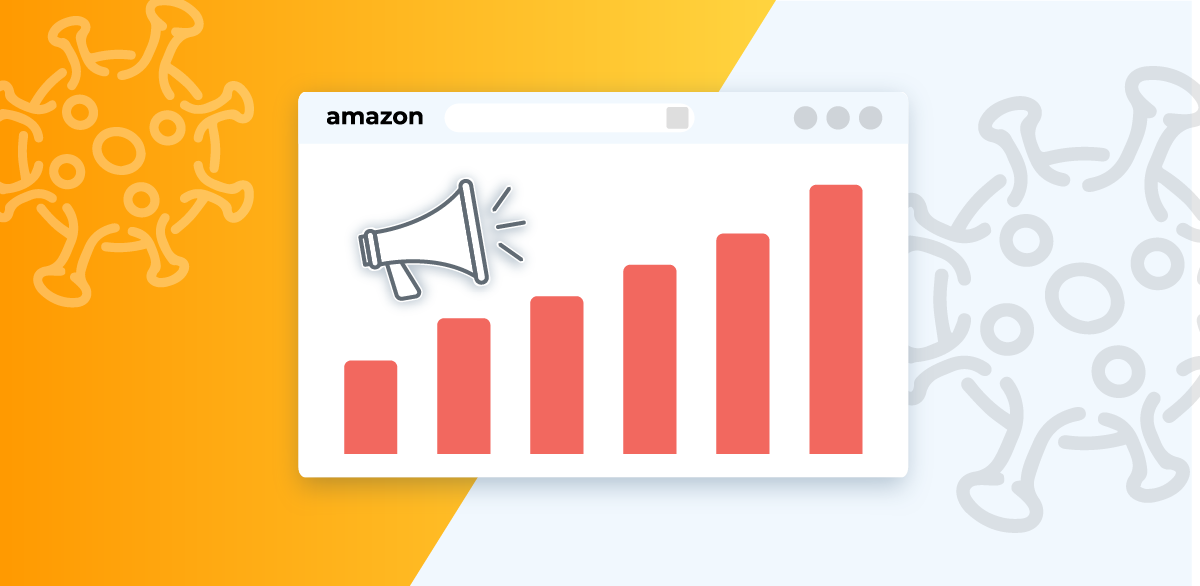
Amazon Advertising Trends & Techniques During the Coronavirus Crisis
Robin Hanna, May 20, 2020
The conditions surrounding the coronavirus pandemic have left some brands confused about how best to move forward with their Amazon ads. On the one hand, the demand for certain products has seen significant increases. On the other, concerns over supply chain delays, an uncertain economy, and Amazon’s policy changes regularly present new, often unforeseeable, challenges.
In this article
We’ll analyze PPC performance trends from the end of 2019 until the end of April in three major markets, including the United States, Germany, and the United Kingdom. And, we’ll discuss how the constellation of market changes and events brought on by the coronavirus pandemic has affected important metrics.
To help you determine what this means for your business and, mostly, your Amazon PPC campaigns, we’ll also offer comprehensive guidelines for running a thriving ad campaign during the coronavirus pandemic now and as the situation continues to evolve.
Looking for more Amazon PPC background, data, and insights?
Whether you’re interested in a high-level analysis of Amazon Advertising, a detailed look at recent marketplace trends, or a deep dive into the nuances of specific product categories, our 2022 Amazon Advertising Benchmark Report can help you gain insight into the Amazon PPC landscape.
The report is based on a comprehensive analysis of over 2 million Sponsored Products campaigns and you can download it for free today.
Looking Back: Early Expectations Regarding Amazon PPC Ads During the COVID-19 Pandemic
In mid-March, following the round of lockdowns due to calls for social distancing over COVID-19, we asked Sellics users:

Back then, almost 40% (39.7%) of users surveyed indicated that they would reduce their spend.
We can attribute this to the climate of uncertainty at that time. With a lack of confidence in the future, increasing or even maintaining your Amazon Ad budget might seem reckless or risky - and rightfully so.
Brands also balanced - and many still do - concerns over the ability of their product supply chain to deliver on the current demand.
Of course, since we distributed our survey, the climate and sentiment have evolved quite a bit. While there is no shortage of uncertainty, some brands are now settling into the ‘new normal’.
Summary: The New Normal - Amazon Advertising Trends During the Coronavirus Crisis
During times of economic precariousness, brands may be tempted to save on ad spend or - at least - to limit spend to the areas of highest return. For brands selling physical products, that place is very likely to be Amazon, over Facebook, or Google.
Overall, our analysis tells us that the current moment is indeed a prime time for running PPC campaigns on Amazon. This suggests it could be beneficial to increase your advertising investment. Of course, this should be done strategically - more on that later.
Our analysis is based on anonymized Sponsored Products performance data from advertiser profiles managed with Sellics. The trends and figures included do not represent an official performance statement of Amazon Advertising.
These are the general Amazon advertising trends we observed since the coronavirus crisis started:
The overall volume of ad revenue and ad spend has increased
This is underpinned by an increase of traffic (clicks on ads)
At the same time advertising efficiency (ACoS and ROAS) has improved. This can be explained to a large degree by:
Lower cost per click (CPC) as competition decreased
And fluctuations in conversion rate (CVR)
The following charts show the most important of these trends for the US, UK and Germany.
In our charts we marked the beginning of March 2020 where the crisis in the US and Europe started to heat up. The exact timelines vary by country but included the following events, which had a major influence on ad performance (see a detailed timeline below):
Nationwide lockdowns
Amazon FBA restrictions for non-essentials items
Shipping delays on Amazon
Amazon announces plans for hiring a total additional 175,000 staff members
Amazon FBA reopening for non-essential items
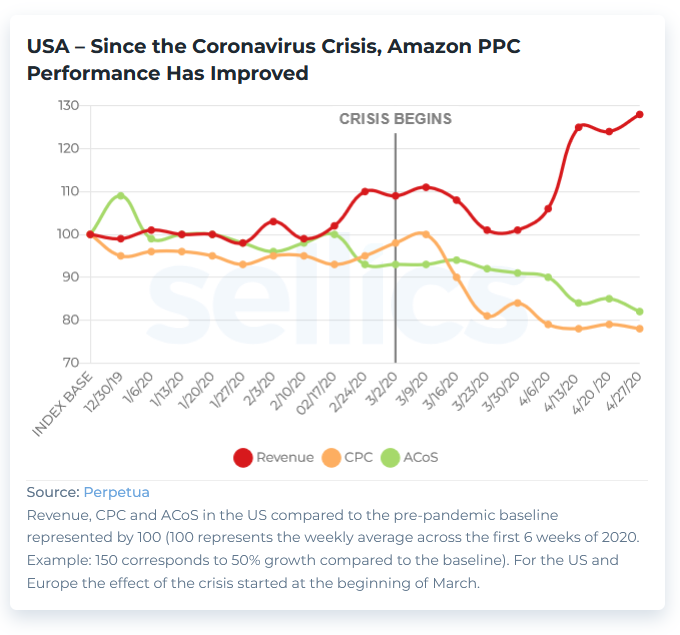
Revenue, CPC and ACoS in the US compared to the pre-pandemic baseline represented by 100 (100 represents the weekly average across the first 6 weeks of 2020. Example: 150 corresponds to 50% growth compared to the baseline). For the US and Europe the effect of the crisis started at the beginning of March.
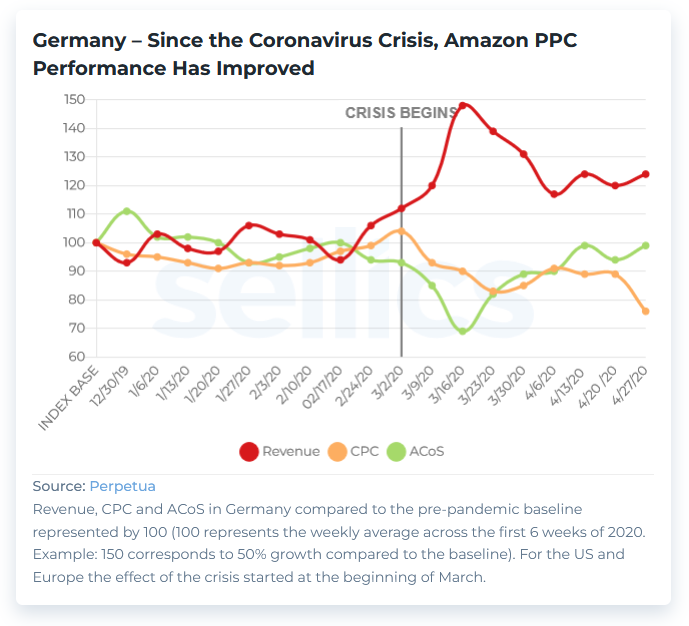
Revenue, CPC and ACoS in Germany compared to the pre-pandemic baseline represented by 100 (100 represents the weekly average across the first 6 weeks of 2020. Example: 150 corresponds to 50% growth compared to the baseline). For the US and Europe the effect of the crisis started at the beginning of March.
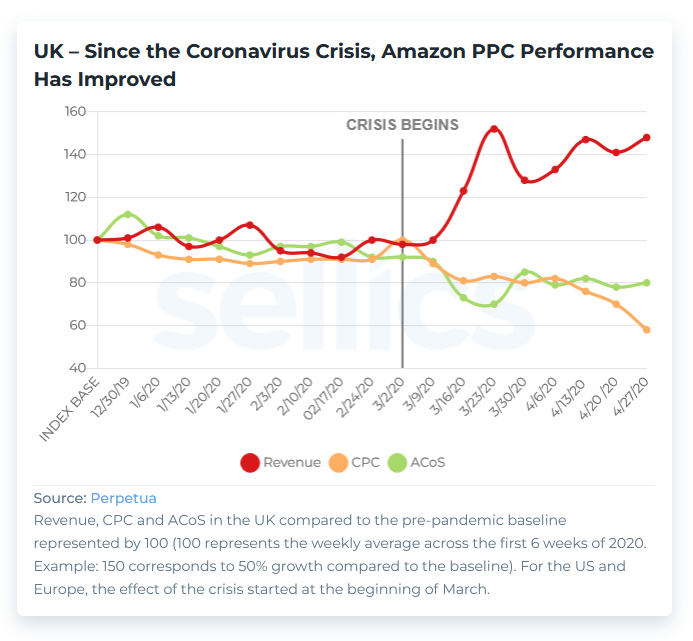
Revenue, CPC and ACoS in the UK compared to the pre-pandemic baseline represented by 100 (100 represents the weekly average across the first 6 weeks of 2020. Example: 150 corresponds to 50% growth compared to the baseline). For the US and Europe, the effect of the crisis started at the beginning of March.
Coronavirus – Amazon PPC Trend #1: Overall Volume In Revenue & Spend Is Up
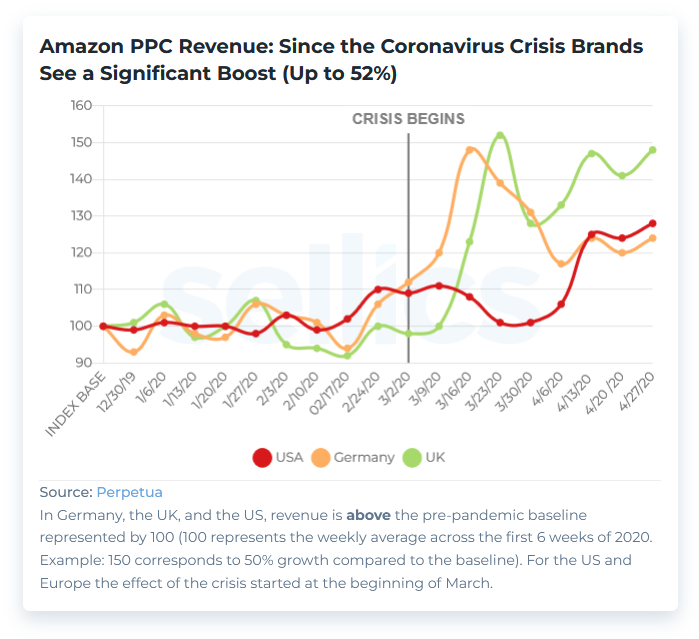
In Germany, the UK, and the US, revenue is above the pre-pandemic baseline represented by 100 (100 represents the weekly average across the first 6 weeks of 2020. Example: 150 corresponds to 50% growth compared to the baseline). For the US and Europe the effect of the crisis started at the beginning of March.
Since the coronavirus crisis started in March, increased traffic and demand led to increased volumes in both advertising revenue and advertising spend. Additionally - reinforcing this trend - because brands see a higher demand as well as better value on their advertising spend (ACoS or ROAS, more on that below), it only makes sense that they reacted by increasing their investment (ad spend is up). In turn, this increased spend is rewarded with higher revenue.
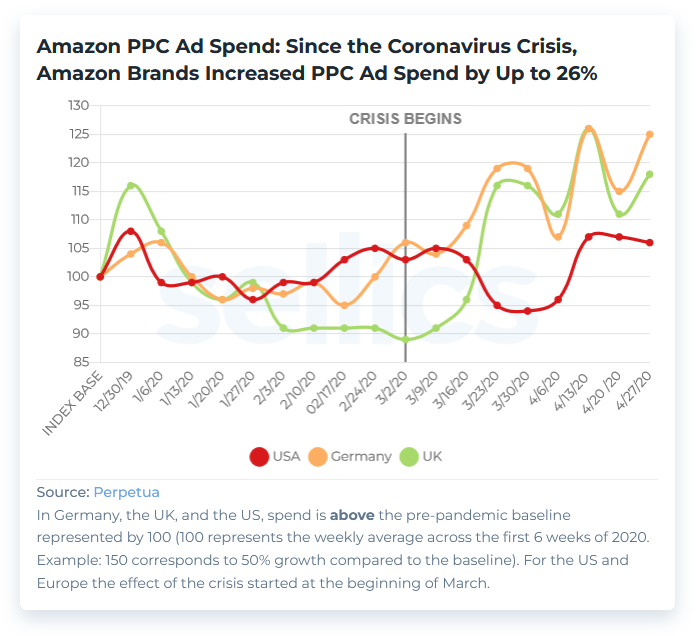
In Germany, the UK, and the US, spend is above the pre-pandemic baseline represented by 100 (100 represents the weekly average across the first 6 weeks of 2020. Example: 150 corresponds to 50% growth compared to the baseline). For the US and Europe the effect of the crisis started at the beginning of March.
In fact, Amazon advertising revenues have not only increased compared to the beginning of 2020 and in spite of the coronavirus crisis. To account for seasonal growth, we also looked at year over year revenue. The result: revenues grew during the crisis months, March and April (compared to February). The trend is especially pronounced for Germany and the UK, but considering the absolute volume, the US also saw a significant boost.
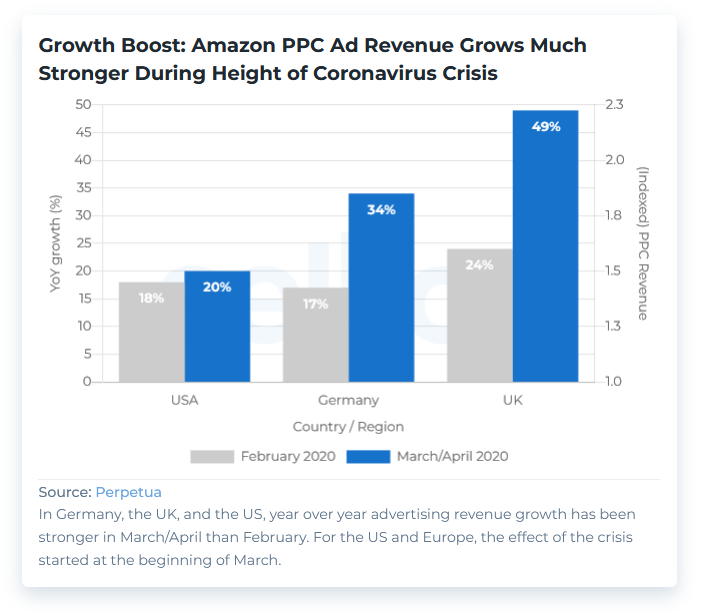
In Germany, the UK, and the US, year over year advertising revenue growth has been stronger in March/April than February. For the US and Europe, the effect of the crisis started at the beginning of March.
Coronavirus – Amazon PPC Trend #2: Overall Traffic Volume Is Up
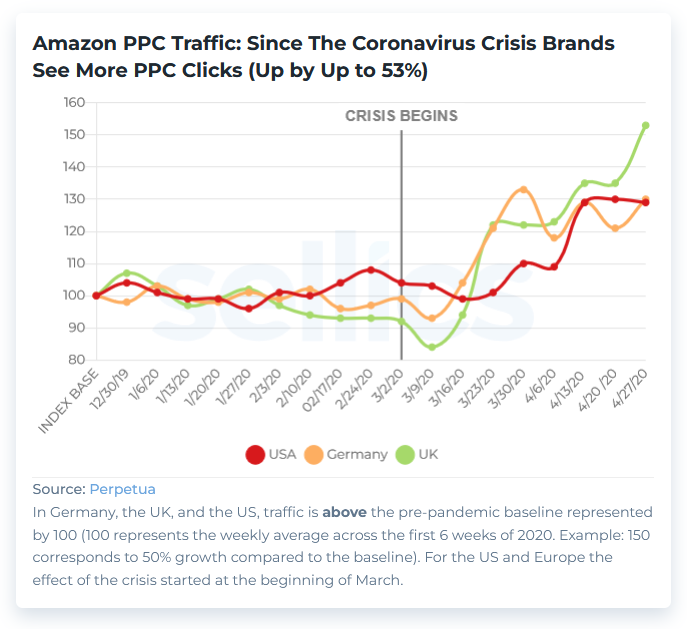
In Germany, the UK, and the US, traffic is above the pre-pandemic baseline represented by 100 (100 represents the weekly average across the first 6 weeks of 2020. Example: 150 corresponds to 50% growth compared to the baseline). For the US and Europe the effect of the crisis started at the beginning of March.
Advertising clicks have increased since the crisis started in March, pointing to an overall increase of traffic to the Amazon websites. Simply, the increase in revenues is due to the increase in shoppers visiting the Amazon marketplace.
Coronavirus – Amazon PPC Trend #3: Ads are more efficient: ACoS is Down / ROAS is Up
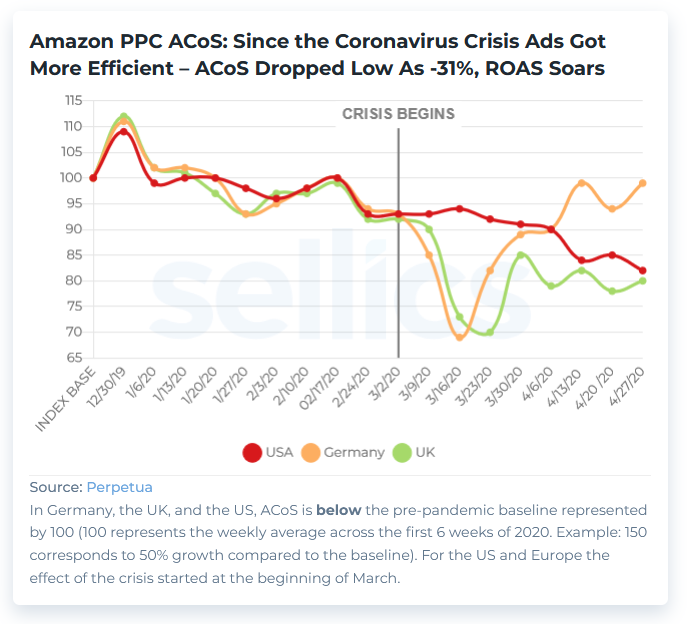
In Germany, the UK, and the US, ACoS is below the pre-pandemic baseline represented by 100 (100 represents the weekly average across the first 6 weeks of 2020. Example: 150 corresponds to 50% growth compared to the baseline). For the US and Europe the effect of the crisis started at the beginning of March.
Seeing overall increased volumes in terms of revenue and traffic you might wonder what happened to advertising efficiency, i.e. ACoS (ad spend / ad revenue). Do you get more revenue for every advertising dollar you spend?
The answer: Generally ACoS has improved since the coronavirus crisis started. For Germany, it has now started to normalize step by step, but in the US and UK, ACoS is still very favorable.
ACoS is directly related to return on ad spend (ROAS = ad revenue / ad spend). That means ROAS has increased in turn.
These improvements in ACoS and ROAS can be largely attributed to the trends in conversion rate (CvR) and cost per click (CPC).
Coronavirus –Amazon PPC Performance Trend #4: CPC is Down
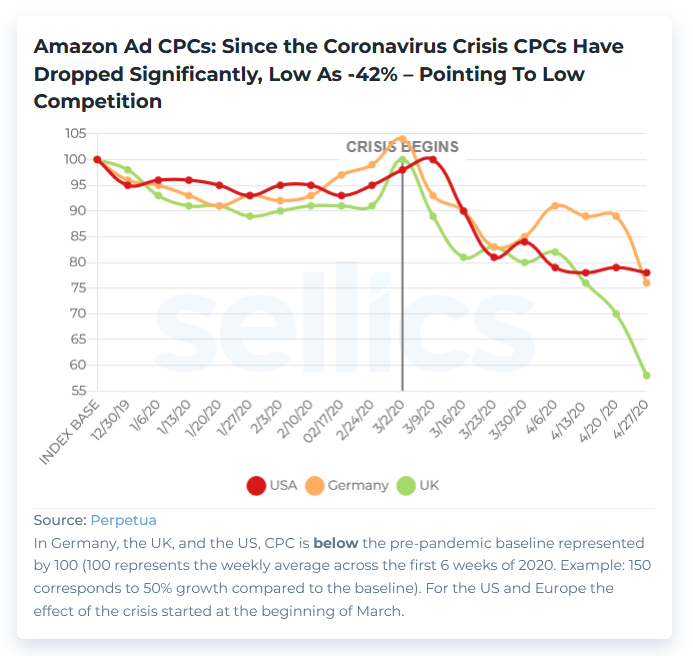
In Germany, the UK, and the US, CPC is below the pre-pandemic baseline represented by 100 (100 represents the weekly average across the first 6 weeks of 2020. Example: 150 corresponds to 50% growth compared to the baseline). For the US and Europe the effect of the crisis started at the beginning of March.
Cost per click (CPC) has decreased since the crisis started due to less competition.
Why? Amazon PPC ads are charged by clicks. Because click prices are determined by bids in an auction, less competition, i.e. fewer players and decreased bids mean ultimately a lower market price for ad placements, resulting in a lower cost per click, (CPC).
This trend is one of the major reasons why ACoS and ROAS have improved and advertising yields better results.
Coronavirus –Amazon PPC Performance Trend #5: Conversion Rate Saw Major Fluctuations (And Is Finally Stabilizing)
The second reason explaining the ACoS/ROAS trend is conversion rate (CvR) - although there have been significant fluctuations due to different events during the crisis. Let’s have a look at the data to see what happened.
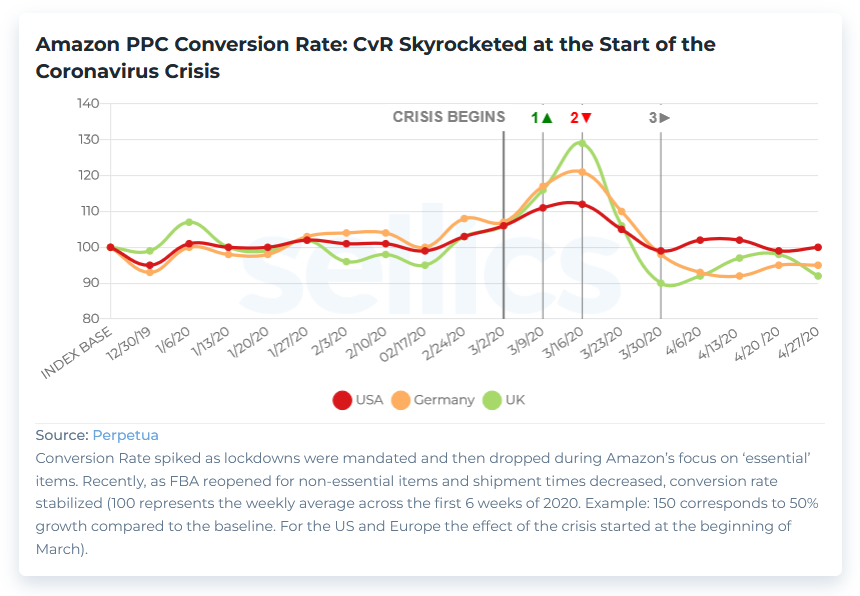
Conversion Rate spiked as lockdowns were mandated and then dropped during Amazon’s focus on ‘essential’ items. Recently, as FBA reopened for non-essential items and shipment times decreased, conversion rate stabilized (100 represents the weekly average across the first 6 weeks of 2020. Example: 150 corresponds to 50% growth compared to the baseline. For the US and Europe the effect of the crisis started at the beginning of March).
There have been three phases for conversion rates:
Increase in CvR along with increased demand at the beginning of the crisis (weeks 3/9/2020 to 3/16/2020)
Decrease in CvR due to shipping delays (caused by FBA restrictions amongst other things, weeks 3/16/2020 to 3/30/2020)
Stabilization of CvR as shipping times decreased again – step by step (caused by FBA reopening for non-essentials amongst other things, weeks 3/30/2020 to 4/27/2020)
If there is one thing Amazon brands know to be true about consumers, it’s that they are not patient – seeing a significant shipping delay is very likely to encourage customers to navigate away instead of completing their purchase (converting) – causing a drop in CvR.
But now that Amazon has lifted its FBA restrictions and made key improvements to keep up with demand (increase in staff, etc.) conversion rates have been stabilizing. As shipping times continue to decrease, conversion rate is also likely to rise, as demand is still strong for online shopping.
See the following timeline for a detailed analysis:
WEEKS | SOCIAL CONDITIONS (USA) | AMAZON ACTIVITY | AMAZON PPC CONVERSION RATE PERFORMANCE |
|---|---|---|---|
3/9/2020 to 3/16/2020 | Awareness around the threat of Covid-19 builds. Travel restrictions are implemented, the CDC advises against large gatherings, and schools are ordered to close in NYC. The result is an increase in demand for online shopping | Amazon announces plans for 100,000 hires to keep up with demand on fulfillment network (March 16) | CvR increases in tandem with high demand for online shopping |
3/16/2020 to 3/30/2020 | Lockdowns are implemented and persist. Social distancing measures include business closures or mandatory work from home for many | Amazon announces prioritizing ‘essential’ items, meaning restricting inbound shipment for FBA (March 17) First shipping delays for non-essential items are observed. Outbound shipping delays persist, which is confirmed in a statement by Amazon (on March 23rd) | Slow shipping times and out of stock discourages order completion – CvR decreases
|
3/30/2020 to 4/27/2020 | Possibility of loosening social distancing measures by state as of April 16th | Amazon announces plans for 75,000 more new hires to keep up with demand on fulfillment network (April 13) FBA is resumed for non-essential items (April 18) Step by step shorter shipping times are observed. | As shorter shipping times are observed, CvR begins to normalize. |
Outlook | A mix of stay-at-home orders, partial lockdowns, and ‘reopenings’ in the USA. Demand for online shopping & regular function of businesses and warehouses is likely to vary significantly by state. | Shipping times are likely to normalize due to significant measures (including new hires) to keep up with demand. | With more regular shipping times and an increase in FBA availability, CvR likely to at least stabilize, potentially rise due to increased demand. |
Following fluctuations in March and April, conversion rate is likely to rise in May.
How to Make PPC Campaigns Thrive Amid The Coronavirus Crisis – Amazon Advertising Guidelines
Want PPC tips tailored to the current situation on Amazon?
Download our comprehensive guides now and receive our top tips and a handy checklist.
How well your brand is positioned to thrive from an Amazon PPC campaign standpoint will depend on:
Current demand for your products
Supply and Inventory
Shipping restrictions - Amazon’s and your own
Consider how flexible your current fulfillment arrangement is. If pivoting to FBM when needed is a possibility for your business, this would be an ideal time to consider it
However, either way, we recommend looking for opportunities that the current crisis might present. Here are some tips:
Demand Scenarios & Opportunities for Your Amazon Ad Campaigns
Amazon Ad Scenario #1: Your product belongs to a trending category
Your own sales are likely to have demonstrated to you which products are (now) in high and low demand.
What are Americans buying on Amazon since the COVID-19 pandemic hit?
For meaningful insights at a glance, download our ‘Top & Flop 50 Products on Amazon.com: Shopping Trends During the Coronavirus Crisis’ analysis.
If your products belong to trending categories, this is a great opportunity to increase your Amazon PPC ad budget to make the most of the current scenario, provided that you have plenty of stock and/or the ability to quickly replenish it.
This is an especially significant opportunity for smaller vendors or sellers who primarily sell online. As larger, more established brands might either struggle to keep up stock or have split focus between in-person retail and e-commerce, these smaller brands might, for the first time, have a more equal opportunity to sell and get exposure on Amazon.
A boon time for e-commerce, not affording in-store shelf space may no longer mean less exposure for your brand. That’s good news.
Combined with the current improvement in efficiency (ACoS/ROI) and a decrease in CPC, brands have a unique opportunity to take advantage, by implementing more aggressive advertising techniques for Amazon PPC during the COVID-19 crisis.
What’s more, product exposure and brand awareness earned during this time won’t end once the pandemic is over - offering the potential for longterm market penetration.
Amazon Ad Scenario #2: Your product doesn’t belong to a trending category
If your product doesn’t belong to a trending product category and, as a result, is now facing a (significant) decrease in demand, consider whether a carefully crafted PPC campaign could help to reposition the item.
First, review the trending categories and products.
Consider whether you can pivot the use of your product. Most products have multiple uses and contexts. Focus on those which reflect the current climate and shopping trends.
For example: If you are selling ‘packing cubes’ used for travel, consider whether there is potential to pivot toward a ‘Home Improvement’ function.
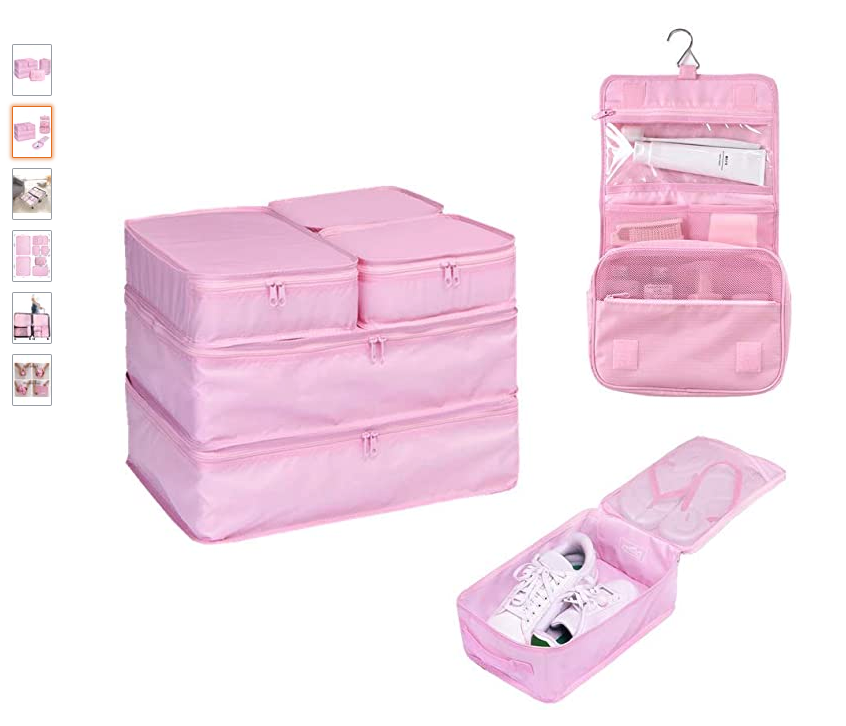
What has previously sold well as ‘packing cubes’ might now sell better as ‘organizational cubes’ for the home. Especially as many consumers both have more time and the interest to invest in their home environment, products that encourage at-home ‘spring cleaning’ projects are likely to do well.
Get creative! Experiment. Use PPC Ad campaigns to drive more traffic to your listings to help you test whether the changes to your content are having a positive impact.
If you can’t pivot the use of your product, consider whether you can pivot the context in which it’s used.
Take a page from major retailer, Banana Republic. While their products seem to be firmly planted in a declining category (Women and Men’s Fashion), they cheekily remerchandised women’s fashion accessories as ‘Video Chat Ready’.

Source: BananaRepublic.com
Ask yourself whether it’s possible that your product can be useful for use at home, in the backyard, or as part of a creative project, (agreeing with some of the top-selling coronavirus category sales trends) and then make a list.
Next, use your PPC ad campaigns to then target up to ten loosely related trending categories on Amazon.
Experiment with an open mind and the expectation that half or more of your PPC ads won’t receive any impressions. Don’t get discouraged. Because of the current situation on Amazon (described above), your opportunity for success is higher.
Besides that, remember that sales in new categories are likely to be incremental sales - meaning that you would not have otherwise made under ‘normal’ conditions. An increase in incremental sales has a long term positive impact on your product’s position.
Regarding product position, remember to continuously audit your keywords. Remember that a change to shopping trends means a change in what consumers are searching for.
If no amount of creative repositioning affects the demand for your product, all is not lost.
As creative of a marketer you may be, it still might be that you won’t find another use, combination or context for certain products now facing a downward selling trend, resulting in diminished PPC activity for your brand. For example luggage.
In this case, you may want to focus on your long term brand strategy and take advantage of the increase in downtime for your brand.
Seize the opportunity to do SEO. Mainly: audit your product listings to be sure that your products index for as many relevant keywords as possible.
Need an education in Amazon SEO?
Check out our Ultimate Guide to Higher Product Ranking in 2020 (With Tips & Examples!).
If you don’t have Sellics to check on your keyword rankings, you can perform a manual check by searching on Amazon: “ASIN Number” + “keyword”. If your product appears, it is indexed for that keyword.
Invest time in creating quality content to take advantage of the likelihood that users will spend more time browsing than usual.
Considering an investment in content?
Start here: Learn more about Amazon A+ Content and how to open your very own Brand Store.
Do Amazon Advertising Spring Cleaning: Organize your campaigns, update your naming conventions, and tackle other important but not urgent tasks.
Is your campaign structure serving you?
Our recommended strategy is tried and true.
As a final note of encouragement, quarantine measures and travel restrictions certainly won’t last forever. And in the meantime, consumers will continue to browse and shop online.
At some point, it is possible, even likely that categories that have so far suffered will see a resurgence in demand as consumers mentally prepare to venture back outdoors - and want to put their best foot forward when doing so.
It’s also possible that just as we are currently seeing an increase in ‘Self Care’ purchases, that consumers will make aspirational purchases out of boredom. All things considered, what is good for e-commerce will ultimately be good for your brand if you are positioned to sell well on Amazon, despite the immediate circumstances brought on by the coronavirus crisis.
But wait - there's more!
We couldn't fit all of our recommendations here. Download the rest here, and get receive a handy to-do list too.
Summary and Key Takeaways: Amazon PPC Advertising During the Coronavirus Crisis
Overall Amazon PPC performance has been very positive since the crisis started. These are the general advertising trends we observed:
The overall volume of ad revenue and ad spend has increased
This is underpinned by an increase of traffic (clicks on ads)
At the same time advertising efficiency (ACoS and ROAS) has improved. This can be explained to a large degree by:
Lower cost per click (CPC) as competition decreased
And fluctuations in conversion rate (CVR)
These trends generally suggest an increase of advertising investment. However, this should be done strategically.
What works best for you and your brand will depend on a combination of the current social conditions brought on by the COVID-19 pandemic and a number of factors specific to your business.
The most important takeaway is not to rely on ‘tried and true’ tactics� during this uncertain time.
In sum, we can recommend:
If your product is in a trending category, this is a great opportunity to increase your PPC ad budget to make the most of the current scenario, provided that you have plenty of stock and/or the ability to quickly replenish it.
If your product is not in a trending category, options include repositioning your product or marketing it in different combinations and contexts. Alternatively try to use the time to do things that tend to be seen as important but not urgent like SEO and quality content for your product listings or reorganising your campaign structure and naming.
Looking for more insights to improve your campaigns? Find the rest of our recommendations here.
To have successful PPC campaigns during the conditions brought on by the coronavirus pandemic, you should be bold and creative. Experiment, test, and implement changes accordingly. Don’t be afraid to make mistakes. To avoid them being costly, monitor your budget carefully, and don’t rely on ‘default’ settings. Build a custom, smart, ad strategy.
Need a smart ad strategy?
Top sellers use cutting-edge advertising tools
Perpetua offers the most advanced Amazon PPC solution on the market, with all the tools, resources, and expert support you need to build successful campaigns for your products. And what’s more, it couldn’t be easier to get started. Request a free demo today to discover the industry’s premier optimization and intelligence software for Amazon Ads.
To get started or learn more about how Perpetua can help you scale your Amazon Advertising business, contact us at hello@perpetua.io